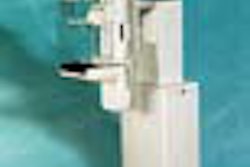Now that the first full-field digital mammography system has been cleared by the Food and Drug Administration, market analysts are speculating about who will be the next vendor to join GE Medical Systems in the digital fray. One full-field hopeful, Fischer Imaging, plans to file for FDA clearance by the first half of this year for its system, called SenoScan.
Fischer has been developing SenoScan since 1993 as part of a collaboration with the Lawrence Livermore National Laboratory of Livermore, CA. Fischer has chosen charge-coupled device (CCD) sensors for its unit, unlike GE's Senographe 2000D, which uses flat-panel detectors.
With more than 30 years of use in other industries, CCDs are a proven, durable and relatively inexpensive technology, according to Mike Tessic, vice president of R&D for the Denver-based firm. In addition, CCDs generate images with very small pixels, which confers spatial resolution advantages over flat-panel approaches, he said.
In normal imaging mode, SenoScan provides image resolution of 50 microns. Magnification mode yields a resolution of 25 microns, he said. Some of the flat-panel systems have image resolution in the 100-micron range.
"In comparison with film, the ultimate limiting resolution of SenoScan is 10 line pairs per millimeter," he said. "While film can resolve up to 20 line pairs, we feel that 15 line pairs is very comparable to what you would obtain with film in a routine fashion. And we feel that we make up for it in contrast resolution."
SenoScan also makes use of Fischer's slot-scanning technology, which involves scanning a thin x-ray beam across the breast concurrently with an array of CCDs below the breast. With this approach, data is collected several thousand points at a time, minimizing scatter radiation and improving image quality, according to the firm. It also offers dose reduction of over 30% compared with traditional mammography methods, Tessic said.
The first SenoScan images were obtained in November 1995 by breast imaging expert Dr. Stephen Feig of Thomas Jefferson University in Philadelphia. Other sites that have beta-tested SenoScan include: University of North Carolina at Chapel Hill; University of California, San Francisco; Sunnybrook Health Science Centre in Toronto; Sally Jobe Breast Center in Denver; and Brooke Army Medical Center in Fort Sam Houston, TX.
A move towards clearance
Fischer's quest for FDA clearance has been a long process. The vendor began collecting clinical data for SenoScan in 1995, and has appeared close to applying for 510(k) clearance several times over the last few years. But the firm was hurt by the FDA's changing guidelines for the regulation of digital mammography. In the fall of 1999, the FDA informally suggested that vendors consider the pre-market approval (PMA) application process. A PMA would not require a digital mammography firm to demonstrate substantial equivalence with film-screen mammography, a challenging task for vendors.
Fischer has not yet decided whether to file a 510(k) or a PMA, but the company expects to submit SenoScan for regulatory action by the end of the second quarter, Tessic said. The vendor is analyzing data from its clinical trials to determine what approach it will take. Fischer has clinical data from approximately 2,000 patients with the current version of SenoScan, which is in its fourth generation.
Like GE, Fischer will initially file for use in hard-copy applications, for both screening and diagnostic applications. A follow-on submission for soft-copy use will come later, Tessic said.
Fischer also plans to market SenoScan outside of the U.S. Final pricing has not yet been determined, but will likely range from approximately $300,000 to $400,000, he said.
In other SenoScan developments, Fischer is exploring the addition of computer-aided detection technology to SenoScan. The firm has had discussions with Qualia Computing of Beaver Creek, OH, for access to its Second Look technology, and hopes to interface SenoScan to all other CAD developers, Tessic said.
Fischer is also looking at expanding clinical applications for SenoScan. At the 1999 RSNA meeting, Fischer discussed the potential for applying the unit in breast angiography applications, studying opacity of the breast following injection of contrast media. The vendor also highlighted the HIS/RIS/PACS interfacing capabilities of SenoScan.
Some market analysts believe that digital mammography systems will face substantial barriers to widespread implementation, due to a number of factors, including the high cost of the technology. But Fischer believes that initial purchasing levels will be strong.
"Systems will be (purchased) pretty quickly as long as the quality is there," Tessic said. "In the initial wave of purchasing, a few hundred machines will be sold and price is not going to be a huge barrier for those customers. And as the technology becomes more widespread, the price will come down."
By Erik L. Ridley
AuntMinnie.com staff writer
February 22, 2000
(This is the first in a series of AuntMinnie.com articles focusing on digital mammography technology.)
Copyright © 2000 AuntMinnie.com

















